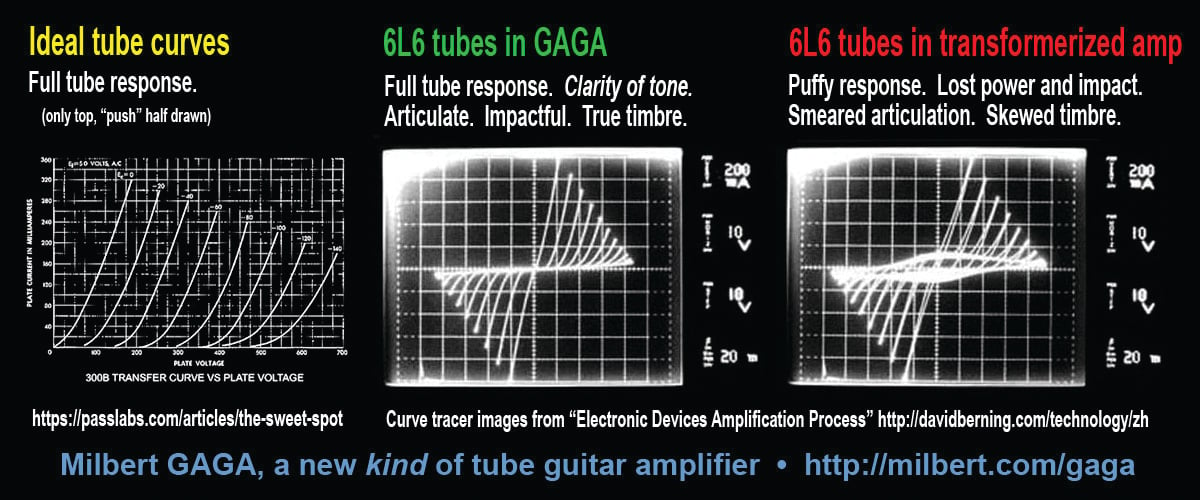Were audio output transformers “so good,” why does not even one tube amp use two, three, or even ten, for “killer” tone made completely out of this world? It’s because the sonic magic comes from the tubes, not their ubiquitous audio output transformers, which are mundane, necessary evils used to translate the tubes’ high-impedance to relatively low-impedance speakers.
LOST IN TRANSLATION
Traditional audio output transformers always homogenize the sound, limiting the power translated and its tonal characteristics – like a large filter that can never be turned off or adjusted. Since practically no one has ever played tubes without this significant veil, essentially all ideas of “good tone” — and what begets it – are inescapably jaded by wire-wrapped, black-art metal bulks. Causal superstitions relating “good tone” and traditional magnetics are incorrect as may be readily dismissed by adding any 1:1 transformer(s) between any amplifier and its speaker: The tone is always worsened, audibly and measurably; adding big metal filters never improves tone*.
Moreover, mythical associations between good tone and “limited bandwidth” may be instantly dispelled by playing guitar while wearing gloves, through a telephone, with tape or gum on strings, or with a pillow pressed against the speaker. The “bright” switch itself, that extreme overloader of high frequencies found on many amps, seeks tonal improvement by dramatically over-compensating the substantial high-end roll-offs imposed by large, intrinsically dull speakers. While this may be subject to taste, many teachers, mavens and artists consistently insist that ‘good tone begins clean’ …and ‘clean’ connotes broad, unlimited, undistorted: if pre-corrupted with distortions and limitations, where can tone ultimately go?
APOTHEOSIS OF TONE
GAGA, the Guitar Artists Guitar Amplifier, eliminates all traditional power and audio magnetics and uses advanced power conversion and other patented innovations (specifically not massively paralleled power tubes) to uniquely convey maximum tube tone and to attain what has previously been elusive: the verifiably purest-possible tube performance and a stunning “clarity of tone” that unleashes cleaner cleans, dirtier dirties, and a more natural, most-musical ecstasy. By removing all the audio-frequency magnetics from between tubes and speakers (and elsewhere), GAGA gets musicians closer to their magical, musical truth.
Bias collapse and overload hangover vanishes; articulation, even if mired in total distortion, retains per-note responsiveness. Power tube and pre-amp tube overload characteristics are changeable and convey completely. This must not be misconstrued as “hi-fi,” “overly analytical” or “sterile”; rather, GAGA amplifies a more faithful muse, conjuring truer tone from instrument and playing, ensuring tighter, fuller interactions among tubes, speakers, instruments and musicians – savoring, not obliterating even the finest and most delicate nuances. All manner of sonic signatures and various overload and distortion flavors can be subsequently explored and added to taste.
Made with top-quality components true to audiophile standards (per its esoteric pedigree) GAGA allows for thoroughly enjoying various tubes, instruments and playing. And, with well over 1.6 million possible “tube cocktail” combinations available by plug-n-play mixing a few dozen types of tubes, GAGA can be like getting a new amp, every day, for the next several thousand years. On many levels, in many ways, there is nothing else even remotely like GAGA.
These are big claims, so let’s examine what good tone looks like and how, in part, GAGA does its magic.

The chart shown in this article shows idealized 300B vacuum tube transfer curves, basically a near-perfect representation of amplification; notice how clean and distinct the lines are. Toward this, all pure amplification fundamentally aspires.
The middle image shows the performance of a pair of 6L6 power tubes applied in the patented circuitry used in GAGA. Notice how similarly clean and distinct the diagonal lines are, indicating clarity of tone, with no phase skew and faithful, true timbre.
The final image shows the same pair of 6L6 output tubes driving a high-quality audio output transformer in a traditional amplifier circuit. Some of the problems with transformers are evident. The looping distortions of the diagonal lines are caused by the transformer’s magnetizing current, visually indicating audible smearing. The large horizontally oriented loop is the result of a mixture of the onset of core saturation and hysteresis, a major source of audible istortion that manifests as “munge” or “flub.” Notice also that the slope of the diagonal lines has changed, invariably upsetting natural timbre, nuance, and “air”.
* “… adding big metal filters never improves tone” but exchanging a smaller transformer (that is insufficient to support the magnetic field required to accurately convey lower frequencies) for a larger one generally improves low-frequency performance, but at the expense of greater phase skew and power loss at high-frequencies. Wide-band audio output transformers are notoriously difficult to make, tend to be costly, and still suffer various unavoidable anomalies – much better to eliminate them altogether and let the tubes shine and play forth.
This article is adapted from the detailed and sourced organic white-paper at http://milbert.com/tubes_vs_transformers which examines a) how audio output transformers negatively affect tone and performance b) presents various data, gathered over long periods and across genres, that consistently relate purity and excellence c) shares research into how and why GAGA gets musicians closer to their true tone and d) details simple but conclusive listening and performance tests using any amp.
Made for discerning musicians, GAGA is a new kind of tube guitar amplifier, fundamentally unique among all others, and while new isn’t always better, sometimes it is. We welcome musicians seeking to explore previously unattainable tube tones, to enjoy all the best of what tubes can do with none of their traditional drawbacks; take a look, listen, and play. Hearing and measuring is believing; playing is proof.
For more info, please visit www.milbert.com/gaga
